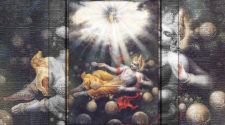Umaputra, part of an incomparable family.
In the Puranas, ‘Himalaya’ is considered to be a ‘King’. His wife’s name is said to be ‘Menaka’ and they had a daughter named ‘Parvati’ (Daughter of Mountain) or Uma (Bright or Night). Parvati was considered to be the embodiment of ‘Durga’ along with being the reincarnation of Dakshayani or Sati, who was the daughter of Daksha Prajapati (God of the Kings) and the first consort of Shiva (God of the Gods), reborn to Himalaya and Menaka after her sorrowful demise.
Parvati was said to have born with a drive to marry Shiva and after years of penance, she could find him and forward her proposal to a depressed, untidy, pessimistic and unenthusiastic individual, temporarily residing in some crematorium, located at the center of a forest. However Shiva had to accept her proposal, going by the rituals and being a groom, it was impossible for him to directly have a word with Himalaya, with regards to an advancement of the marriage proposal.
The reason why the poor fellow had to summon the Saptarishis (Seven-Holy-Saints without a Superior to Command. Namely – Agastya, Bhardwaja, Vashistha, Jamadagni, Atri, Vishvamitra and Gautama) and command them (Exception Proves the Rule) to have a word with Himalaya, with regards to Parvati’s proposal. The Saptarishis went to Himalaya and imparted the message to the ‘King of Mountains’.
Initially Himalaya could not be certain of what he had just heard from the seven supreme beings. The proposal was beyond the wildest dreams of even the ‘King of Mountains’. Himalaya ran inside the palace and walked back to the Saptarishis followed by his daughter Parvati and wife Menaka. Three of them seemed to be getting prepared for the happiest day of their lives.
“Please invite the ‘God of the Gods’ to pay a visit to our palace and marry our daughter.” – Urged Himalaya.
The Saptarishis forwarded the invitation to Shiva and Shiva decided to return to the Mount Kailash (His Home) after embracing exile for quite a long time. Obviously the ghosts (His Followers), led by Nandi and Bhringi had to initiate the festivities of welcoming their friend back to their locale. Thereafter Shiva had to appoint Narada (Saint-Follower of Narayana or Vishnu), in order to invite the Gods, Yakshas (Nature-Spirits) Apsaras (Divine Performers) and Gandharvas (Heavenly Beings), to the ‘Wedding-Ceremony’. All of them felt so enthusiastic after getting an invitation from Shiva that they turned up at the ‘Wedding Ceremony’ even before Shiva could reach the ceremony. Himalaya and Menaka were standing at the gates to welcome the guests. Every time a guest entered the palace, Menaka was more than astonished and impressed with their appearance and aristocracy.
“Where is Shiva?” – She asked.
“He hasn’t arrived yet.” – Said Himalaya.
Suddenly a lot of ghosts appeared in front of them and started dancing in joy. They were ugly and the ugliest of them was standing at the center. It was an untidy fellow covered in ash and wearing nothing but the skin of a tiger.
“Here’s Shiva” – Narada introduced the groom.
Menaka felt like she would faint.
“Oh my God” – She screamed and ran inside the palace. She went to Parvati and started reprimanding her, for her willingness to marry an untidy fellow who looked like a ‘Demon’ or rather a ‘Beggar’.
Narada tried to intervene but had to accept his share of abuses from Menaka. Menaka did not spare anyone standing over there, including even the Gods, Yakshas, Gandharvas and the Saptarishis. She insisted that the marriage had to be disregarded as she was totally against it.
“Please do not take a hasty decision.” – Urged Vishnu as the smartest of the Gods decided to mediate.
“Nandi, please arrange for water to wash the face of Lord Shiva.” – Said Vishnu.
Once they washed the face of Shiva, Menaka once again felt like losing her senses. The person, who stood in front of her, was the most handsome individual she had ever seen. His looks were as innocent as a child and seemed to be more than embarrassed.
“Oh my God!” – Menaka had to take a U-turn, run to Parvati and start pampering her.
“I knew that I had the smartest of daughters.” – Menaka confirmed.
Next, Himalaya and Menaka apologized to the guests whom Menaka had insulted during the misunderstanding.
The guests seemed to be rather amused, than insulted. The brawl had enlivened their experience of an unorthodox ‘Wedding Ceremony’. Eventually the ceremony concluded successfully and was regarded in high-spirits due to the never-before festivities witnessed by the guests, thereafter.
Vinayaka, the first to be worshipped.
Parvati missed her parents and felt a bit lonely during her stay at Mount Kailash. On top of it, she had privacy related issues because Shiva used to enter the house along with his ghosts, every now and then. He was used to a nomadic life, but having led the life of a princess, Parvati wasn’t used to such rudeness. On top of it, even the Gods didn’t dare to advise Shiva against his reckless lifestyle and even if they dared, Shiva would argue with them and arrogantly chase them away. This eventually made Parvati lose her patience and she decided to consult two of her friends Jaya and Vijaya with regards to finding a cure for her husband’s rash and impulsive attitude. They suggested her to use her divine and immeasurable power (Adi-Paraashakti) to create her baby boy out of ‘Holy-Argil’ (Potter’s Clay), thereby instructing her son to defend the house and to not let anyone in, without her permission.
So that’s how ‘Lord Ganesha’ was born. Parvati kissed him on his forehead and instructed him to be the guard at the door and not let anyone enter the house.
After about an hour Shiva came back home followed by his army of ghosts. He noticed a small boy guarding the door. A similar conversation ensued.
Shiva: Move aside!
Ganesha: Mother Parvati has instructed me not to let you people get inside the house. I have strict orders, so do not dare. Stay out!
Shiva: I am Shiva! I am the husband of Parvati and the ‘God of the Gods’. I said move aside!
Ganesha: No respect whatsoever! Do you see this divine mace gifted by my mother? It makes me invincible during a confrontation. I said stay out or I’ll beat you up with the bludgeon, ‘God of Gods’.
The ghosts started laughing.
Shiva (Now Angry): How dare the kid? Bhringi, ask the ghosts to punish this lad, whoever he might be. Nandi, call all the Gods. I want this kid to apologize in front of them.
Ganesha (Arrogance Personified): These ugly skeletons? They won’t stand a chance!
And so, led by Bhringi, the ghosts attacked Ganesha. The very next moment, Ganesha started by slapping Bhringi so hard, that he blacked out. Thereafter the ghosts got beaten-up by Ganesha, so mercilessly, that their haywire army had to escape from the battleground. It was time for Nandi to attack Ganesha with the help of the Gods, but to no avail. Ganesha attacked them with his bludgeon of invincibility, supported by two divine powers that came with the mace. These powers looked like something that were thousand times brighter than the Sun and consumed all the weapons that were charged on Ganesha, even by the supreme Gods like Brahma (Creator of the Universe) and Indra (King of Gods). Ganesha single-handedly forced them to retreat.
“That little boy, whatever he is, is dangerously powerful and can’t be defeated in a direct confrontation. So I’ll keep him busy, while someone as powerful as Shiva himself needs to execute him by means of an ambush-attack.” – Said anxious Vishnu.
Shiva could not agree to Vishnu’s strategy, but they had no other option to defeat the unforgiving child, who refused to take orders from anyone else, other than his mother. So while Ganesha was on his way to blast someone as powerful as Vishnu, out of the battleground, Shiva had to ambush-attack a child from the rear and decapitate him with his Trishul (Trident). However, the strategy turned out to be the biggest mistake on part of the Gods. When Parvati came to know about the death of her beloved son (Most Beloved), she is said to have created a Thousand-Demons out of her son’s decapitated body (The Head to which could not be Located) and made them attack the entire creation.
The Demons bred out of a mother’s agony were so powerful that they started killing the Gods one after another. When Shiva came to their rescue, the gang of Demons hurt his backbone so badly that he collapsed. The humiliation went up to such an extent, that the Gods had nothing to do, but to give up. They had to accept three of Parvati’s conditions, without any scope of negotiation, for her to neutralize the powers of the Divine-Demons.
- Shiva needed to bring her son back to life!
- Her son would be known as ‘Ganapati’, the ‘God of the Commons’ or ‘Leader of the Supreme God Shiva’s Followers’!
- Her son had to be worshiped before any other God or Goddess, including herself and Shiva, because he would never be second to an aristocrat!
Shiva had to hurriedly accept her terms and instruct his ghosts to go towards the north, decapitate the first creature that they find on their way and implant it in the body of Ganapati. The first creature that they could locate was a white elephant. Following Shiva’s hurried orders, they beheaded the elephant and implanted the head in the body of Ganapati. Thanks to the magical powers of Lord Shiva, to Parvati’s amazement, her son came back to life and ran towards his mother. Seeing her son recuperate, Parvati neutralized the Divine-Demons instantly.
These incidents are said to be the mythological reason why, in Hinduism, Ganesha is worshipped before all the other Gods, including Parvati and Shiva themselves.
Vighnesha, a strategist.
A few days after the marriage, Parvati and Shiva had a son, named Kartikeya. After his birth, Kartikeya was considered to be most handsome of the Gods, eventually earned the title of ‘God of War’, due to his marshaling skills, and left Kailash for a while to stand in the favor of Gods and win battles against the Asuras (Demons). When he returned, Ganesha and Kartikeya had an argument over which one of them was to be the first to get married. Unable to come to an understanding, they had to ask their parents. Being diplomatic and politically-correct, the parents declared that whoever of them would be able to circumambulate the earth (seven times), faster than the other one of them, would be the one to get married before the other. Kartikeya immediately started his journey on the back of a peacock, however Ganesha didn’t. He rested for a few days, walked to his parents and asked if he could worship them going by the rituals of the ‘Vedas’. The parents agreed, Ganesha worshipped them and circumambulated them seven times before concluding the ceremony. Then he argued that since according to the ‘Vedas’, parents were considered to be an equivalent to ‘Mother-Earth’, circumambulating them should be considered to be an equivalent of circumambulating the planet. The parents seemed confused, but since it was according to the Vedas, they had to get Ganesha married before Kartikeya.
When Kartikeya came to know about Ganesha’s marriage, he was so upset, that he decided never to marry. Why Kartikeya is also known by the name ‘Kumar’ (In the sense – Unmarried).
Ekadanta (Ganesha), the fastest transcriber ever.
When the great sage named Veda-Vyasa wished to write the Mahabharata, he knew that it would be impossible for him to write it down during a lifetime. So he had to look for a transcriber who could write down the dictation given by him at an incredible speed. When he approached Ganesha to write it down for him, the polite God did agree to the proposal. However, he had a condition. If at any point of time, Veda Vyasa stopped narrating the story, even to gasp; Ganesha would stop writing and quit the project immediately. Accepting his condition, though being on a defensive mode, Veda-Vyasa came up with his own condition. He requested Ganapati to understand each and every paragraph that was narrated to him, before taking a note of it, to which, Lord Ganapati did not have any objection.
When the project started; little did Veda Vyasa know that Ganesha would be writing, whatever he narrated, at a speed faster than his own speed of narration! Ganesha wrote the paragraphs so fast, that the pen shattered into pieces. But that did not stop the flow of Veda-Vyasa’s transcriber. He broke one of his tusks, dipped it in the ink and started writing at a faster pace.
Now Veda-Vyasa seemed worried. He had to get some rest. So he came up with an idea. He started narrating complicated paragraphs to the ‘Lord of Knowledge’. So complicated, that even Ganesha had to pause, in order to understand the paragraph, before he could take it down. The strategy paid-off for the ‘Sage’, and he could get some rest during that period of time, while eventually the Maha-Kavya (Epic) was recorded successfully.
Due to the tusk that he had broken himself, Ganesha is also known as Eka-Danta (Single-Tusked).
Gajanana, In popular culture.
Ganesha has the most elaborate mention in Ganesha Purana, Ganapati Atharvashirsa and Mudgala-Purana. He has also been analyzed in Brahma Purana and Brahmanda Purana.
He is also known by names like Vinayaka (The Leader), Siddhivinayaka (Presenter of Success), Vighnesha (Remover of Obstacles), Gadadhara (Mace Bearer), Umaputra (Son of Parvati), Ekadanta (With a Broken Tusk), Vakratunda (Curved Faced), Gajanana (Elephant Headed) and Lambodara (Big Bellied).
Other than the Hindus, Ganesha is also worshipped by the Buddhists, Jains and certain communities of other religions. Though Ganesha is associated with the divine word called ‘Om’ (Omkara), in certain sects of Hinduism, the females are forbidden to use the word, are supposed to use the word ‘Namo’ instead and vice versa.
Ganesha is usually portrayed with four hands carrying Elephant-Goad (Ankush), Noose (Paash), Lotus (Padma) and a Pot of Grains (Anna). However, it varies from idol to idol, depending upon the tradition of the way it’s depicted.
The Consorts of Ganesha are Riddhi and Siddhi.
The Vahana (Carrier) of Ganesha is considered to be Mushika (Mouse), however the earliest known references are said to have mentioned his carriers in form of lion, serpent, horse and peacock. However some scholars interpret his carrier i.e. the mouse, in negative light as a pest, others argue that though a pest, a mouse can only be seen penetrating through the places of abundance, which is the sign of prosperity. Been perceived to have been worshiped for more than three thousand years and having a famous dance posture that has been depicted since the Gupta period, in the art forms of many countries in Asia, Ganesha has been a source of inspiration to the artists of the ancient times, residing in countries like Afghanistan, Nepal (He is known as Heramba), China, Japan (Kangi-Ten), Fiji, Bali, Sri Lanka, Thailand, Burma, Bhutan and Tibet (Known as Tshogs Bdag).
Thanks to the legendary son of Shiva and Parvati, we have an entire tradition called the Ganapataya-Tradition dedicated to the kind and compassionate ‘Elephant God’. He is considered to be the lord of commons, protector of followers, mediator between men and Gods, ‘alienor or grantor’ of business-deals, God of wealth and a symbol of intelligence, patience, struggle, skill, knowledge, imagination and acceptance.





















